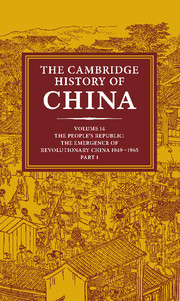Book contents
- Frontmatter
- 1 The reunification of China
- PART 1 EMULATING THE SOVIET MODEL, 1949–1957
- PART II THE SEARCH FOR A CHINESE ROAD, 1958–1965
- 7 The Great Leap Forward and the split in the Yenan leadership
- 8 The Chinese economy under stress, 1958—1965
- 9 New directions in education
- 10 The Party and the intellectuals: phase two
- 11 The Sino-Soviet split
- Bibliographical Essays
- Bibliographical essays for chapters
- Bibliography
- Appendixes: Meetings and Leaders
- Conversion Tables: pinyin and Wade-Giles
- Glossary Index
- Map 1. China’s physical features
- Map 2. PRC: political (Wade–Giles romanization)
- Map 3. PRC: political (pinyin romanization)
- References
8 - The Chinese economy under stress, 1958—1965
from PART II - THE SEARCH FOR A CHINESE ROAD, 1958–1965
Published online by Cambridge University Press: 28 March 2008
- Frontmatter
- 1 The reunification of China
- PART 1 EMULATING THE SOVIET MODEL, 1949–1957
- PART II THE SEARCH FOR A CHINESE ROAD, 1958–1965
- 7 The Great Leap Forward and the split in the Yenan leadership
- 8 The Chinese economy under stress, 1958—1965
- 9 New directions in education
- 10 The Party and the intellectuals: phase two
- 11 The Sino-Soviet split
- Bibliographical Essays
- Bibliographical essays for chapters
- Bibliography
- Appendixes: Meetings and Leaders
- Conversion Tables: pinyin and Wade-Giles
- Glossary Index
- Map 1. China’s physical features
- Map 2. PRC: political (Wade–Giles romanization)
- Map 3. PRC: political (pinyin romanization)
- References
Summary
At the start of the 2nd Five-Year Plan (FYP) (1958—62) there was no consensus within the leadership of the Chinese Communist Party (CCP) on the lessons of the 1st FYP and their implications for China's evolving development strategy. The years from 1953 through 1957 had brought unprecedentedly rapid economic growth, but the strategy of the 1st FYP was being seriously questioned from 1956 onward. Growth in the 1st FYP was quite imbalanced, with an industrial output rising almost five times more rapidly than that of agriculture. Lagging performance in agriculture had allowed less than a 3 percent increase over five years in average per capita consumption of food grains, the source of about 90 percent of total caloric intake, and had substantially constrained the growth of manufactured consumer goods, since they were heavily dependent on supplies of raw materials from the farm sector.
From the point of view of the planners, the continued decline after 1954 in the absolute quantity of grain they were able to extract from the countryside, either in the form of taxes in kind or compulsory sales at fixed prices, was even more critical than the slow growth of output. The reopening of private rural markets in the second half of 1956 had increased the difficulty of fulfilling procurement quotas. Although private market transactions were supposed to be restricted to subsidiary products and items not subject to compulsory quotas for delivery to the state, the scope of the markets quickly expanded to include grain, oil-bearing seeds, and cotton.
Keywords
- Type
- Chapter
- Information
- The Cambridge History of China , pp. 360 - 397Publisher: Cambridge University PressPrint publication year: 1987
References
- 8
- Cited by



